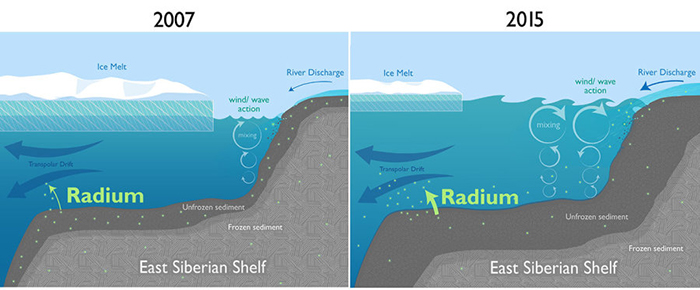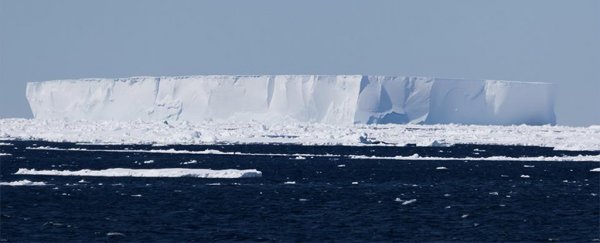The planet's climate is incredibly complex, and scientists are still discovering the effects and consequences of a warming planet – such as a new study finding drastic changes in the chemistry of the ocean waters surrounding the Arctic.
Researchers working near the middle of the Arctic Ocean have found that levels of radium-228 have shot up rapidly over the last decade, as vanishing ice leads to more sediment getting swept up into the water.
Not only does it show how far-reaching and complicated the effects of global warming can be, this could have significant consequences for marine life and the Arctic food chain, according to the researchers, led by a team from the Woods Hole Oceanographic Institution in Massachusetts.
"We suggest that significant changes in the nutrient, carbon, and trace metal balances of the Arctic Ocean are underway, with the potential to affect biological productivity and species assemblages in Arctic surface waters," write the researchers in their paper.
Radium-228 has long been used to work out the flow of land and sediment into the sea – it's a naturally occurring isotope that dissolves into water and so can be tracked by scientists. For this study, multiple ocean readings were taken at 69 sites over the course of a two-month voyage in 2015.
When compared with the previous extensive survey, done in 2007, levels of radium-228 were almost double the recordings from last time.
So what's going on? In an attempt to find out, the team noticed a substantial flow of ice and water moving northwards from Russia along the Transpolar Drift current, ending up in the spot where the increased radium levels had been observed.
That suggests sediments from the East Siberian Arctic Shelf have been making their way from Russia to the centre of the Arctic Ocean.
The scientists think reduced sea ice cover along the Russian coast has led to greater wave activity, as the increased areas of open water get chopped up by the passing winds. That would in turn churn up and release more sediment from the sea bed, including radium and other compounds.
 (Woods Hole Oceanographic Institution)
(Woods Hole Oceanographic Institution)
Extra nutrients, carbon, and other chemicals would likely be released through the same mechanism, which would then provide additional food for the plankton at the bottom of the food chain. The whole ecosystem could be altered, say the scientists.
Other factors that could be at play include the way the extra wave activity might pull more sediment into the ocean though coastal erosion, and the possibility of warming temperatures removing permafrost cover and then leading to greater groundwater runoff.
The end result is a whole new mix of chemicals in the sea.
For that reason the scientists are calling for more research into the area from marine geochemists from all nations – after all, it's already been years since the radium levels in this part of the Arctic have been measured, so shorter gaps between readings could help the science greatly.
Until we get a better set of data we won't know for sure how this part of the world is changing, or what might be done to deal with the consequences.
"Continued monitoring of shelf inputs to Arctic surface waters is therefore vital to understand how the changing climate will affect the chemistry, biology, and economic resources of the Arctic Ocean," conclude the researchers.
The research has been published in Science Advances.
